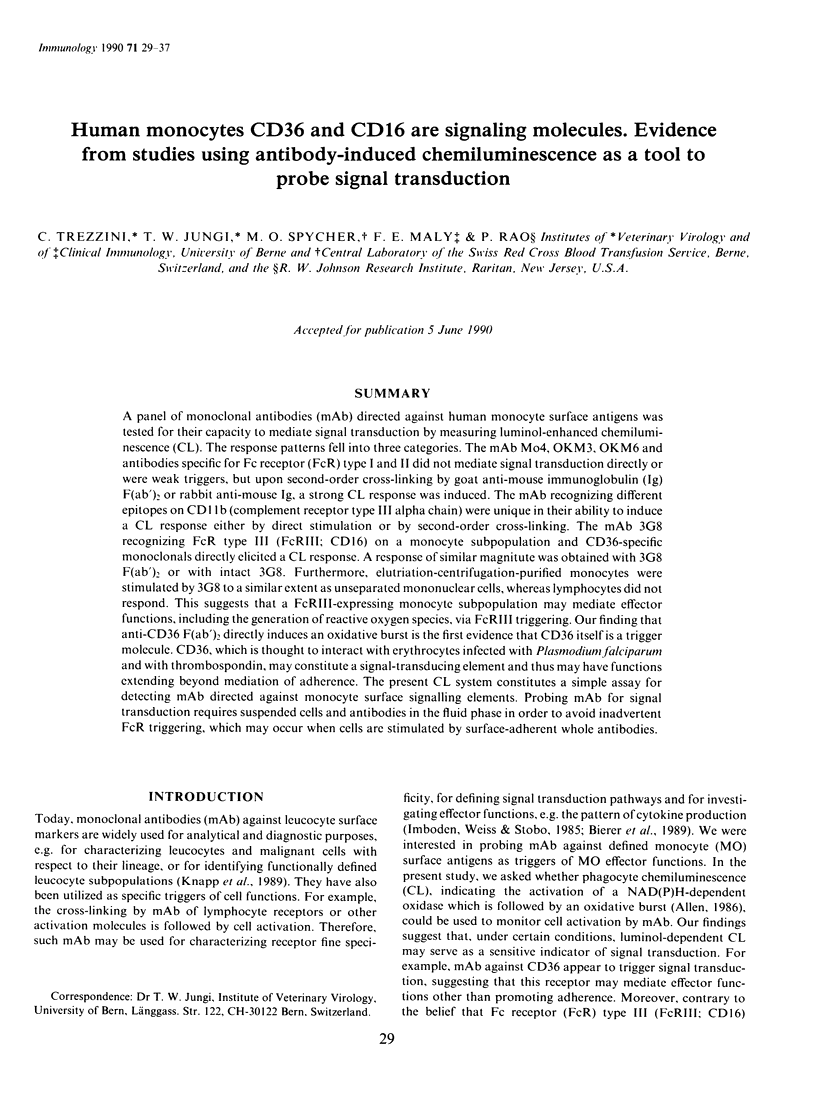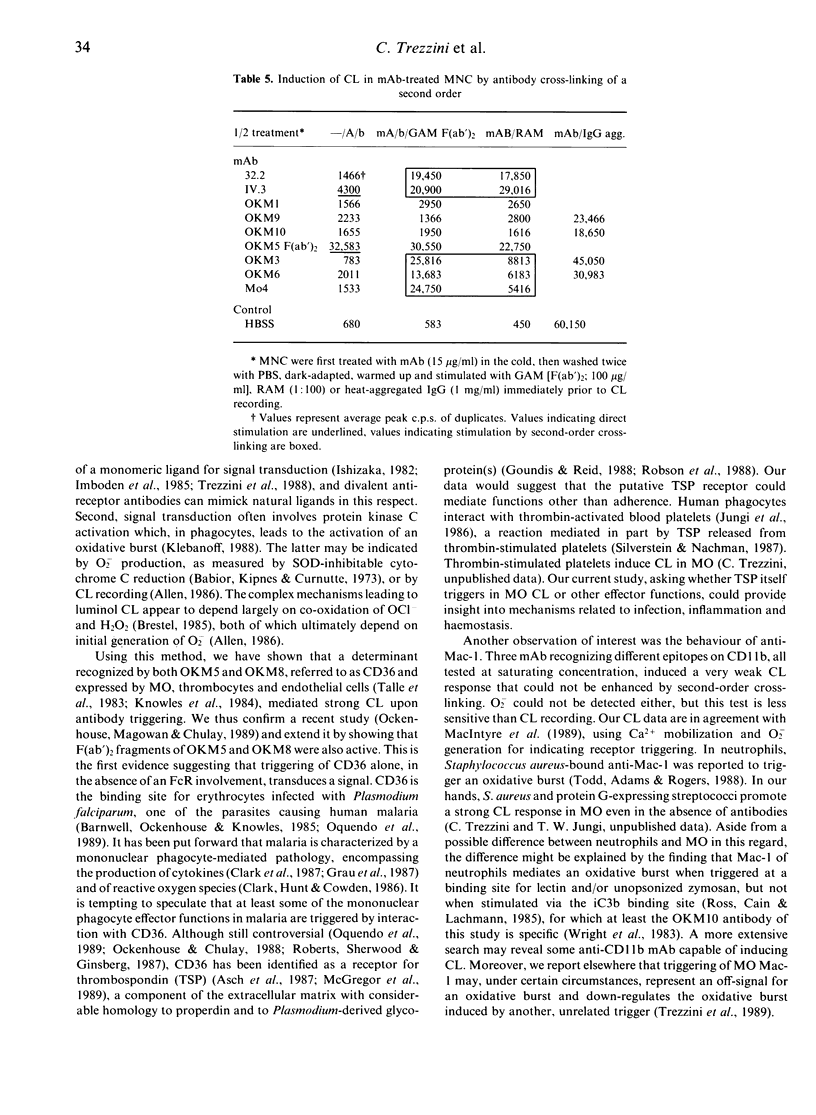Abstract
A panel of monoclonal antibodies (mAb) directed against human monocyte surface antigens was tested for their capacity to mediate signal transduction by measuring luminol-enhanced chemiluminescence (CL). The response patterns fell into three categories. The mAb Mo4, OKM3, OKM6 and antibodies specific for Fc receptor (FcR) type I and II did not mediate signal transduction directly or were weak triggers, but upon second-order cross-linking by goat anti-mouse immunoglobulin (Ig) F(ab')2 or rabbit anti-mouse Ig, a strong CL response was induced. The mAb recognizing different epitopes on CD11b (complement receptor type III alpha chain) were unique in their ability to induce a CL response either by direct stimulation or by second-order cross-linking. The mAb 3G8 recognizing FcR type III (FcRIII; CD16) on a monocyte subpopulation and CD36-specific monoclonals directly elicited a CL response. A response of similar magnitude was obtained with 3G8 F(ab')2 or with intact 3G8. Furthermore, elutriation-centrifugation-purified monocytes were stimulated by 3G8 to a similar extent as unseparated mononuclear cells, whereas lymphocytes did not respond. This suggests that a FcRIII-expressing monocyte subpopulation may mediate effector functions, including the generation of reactive oxygen species, via FcRIII triggering. Our finding that anti-CD36 F(ab')2 directly induces an oxidative burst is the first evidence that CD36 itself is a trigger molecule. CD36, which is thought to interact with erythrocytes infected with Plasmodium falciparum and with thrombospondin, may constitute a signal-transducing element and thus may have functions extending beyond mediation of adherence. The present CL system constitutes a simple assay for detecting mAb directed against monocyte surface signalling elements. Probing mAb for signal transduction requires suspended cells and antibodies in the fluid phase in order to avoid inadvertent FcR triggering, which may occur when cells are stimulated by surface-adherent whole antibodies.
Full text
PDF








Selected References
These references are in PubMed. This may not be the complete list of references from this article.
- Allen R. C. Phagocytic leukocyte oxygenation activities and chemiluminescence: a kinetic approach to analysis. Methods Enzymol. 1986;133:449–493. doi: 10.1016/0076-6879(86)33085-4. [DOI] [PubMed] [Google Scholar]
- Asch A. S., Barnwell J., Silverstein R. L., Nachman R. L. Isolation of the thrombospondin membrane receptor. J Clin Invest. 1987 Apr;79(4):1054–1061. doi: 10.1172/JCI112918. [DOI] [PMC free article] [PubMed] [Google Scholar]
- Babior B. M., Kipnes R. S., Curnutte J. T. Biological defense mechanisms. The production by leukocytes of superoxide, a potential bactericidal agent. J Clin Invest. 1973 Mar;52(3):741–744. doi: 10.1172/JCI107236. [DOI] [PMC free article] [PubMed] [Google Scholar]
- Barnwell J. W., Ockenhouse C. F., Knowles D. M., 2nd Monoclonal antibody OKM5 inhibits the in vitro binding of Plasmodium falciparum-infected erythrocytes to monocytes, endothelial, and C32 melanoma cells. J Immunol. 1985 Nov;135(5):3494–3497. [PubMed] [Google Scholar]
- Benichou G., Voisin G. A. Antibody bipolar bridging: isotype-dependent signals given to guinea pig alveolar macrophages by anti-MHC alloantibodies. Cell Immunol. 1987 May;106(2):304–317. doi: 10.1016/0008-8749(87)90174-2. [DOI] [PubMed] [Google Scholar]
- Bierer B. E., Sleckman B. P., Ratnofsky S. E., Burakoff S. J. The biologic roles of CD2, CD4, and CD8 in T-cell activation. Annu Rev Immunol. 1989;7:579–599. doi: 10.1146/annurev.iy.07.040189.003051. [DOI] [PubMed] [Google Scholar]
- Brestel E. P. Co-oxidation of luminol by hypochlorite and hydrogen peroxide implications for neutrophil chemiluminescence. Biochem Biophys Res Commun. 1985 Jan 16;126(1):482–488. doi: 10.1016/0006-291x(85)90631-x. [DOI] [PubMed] [Google Scholar]
- Clark I. A., Cowden W. B., Butcher G. A., Hunt N. H. Possible roles of tumor necrosis factor in the pathology of malaria. Am J Pathol. 1987 Oct;129(1):192–199. [PMC free article] [PubMed] [Google Scholar]
- Clark I. A., Hunt N. H., Cowden W. B. Oxygen-derived free radicals in the pathogenesis of parasitic disease. Adv Parasitol. 1986;25:1–44. doi: 10.1016/s0065-308x(08)60341-3. [DOI] [PubMed] [Google Scholar]
- Clemetson K. J., McGregor J. L., McEver R. P., Jacques Y. V., Bainton D. F., Domzig W., Baggiolini M. Absence of platelet membrane glycoproteins IIb/IIIa from monocytes. J Exp Med. 1985 May 1;161(5):972–983. doi: 10.1084/jem.161.5.972. [DOI] [PMC free article] [PubMed] [Google Scholar]
- Descamps-Latscha B., Golub R. M., Nguyen A. T., Feuillet-Fieux M. N. Monoclonal antibodies against T cell differentiation antigens initiate stimulation of monocyte/macrophage oxidative metabolism. J Immunol. 1983 Nov;131(5):2500–2507. [PubMed] [Google Scholar]
- Descamps B., Nguyen A. T., Feuillet-Fieux M. N. Flash detection of anti-H-2 antibodies using chemiluminescence, without complement. Ann Immunol (Paris) 1980 Nov-Dec;131D(3):337–346. [PubMed] [Google Scholar]
- Edberg J. C., Redecha P. B., Salmon J. E., Kimberly R. P. Human Fc gamma RIII (CD16). Isoforms with distinct allelic expression, extracellular domains, and membrane linkages on polymorphonuclear and natural killer cells. J Immunol. 1989 Sep 1;143(5):1642–1649. [PubMed] [Google Scholar]
- Ernst M., Lange A., Flad H. D., Havel A., Ennen J., Ulmer A. J. Dissociation of responses measured by natural cytotoxicity and chemiluminescence. Eur J Immunol. 1984 Jul;14(7):634–639. doi: 10.1002/eji.1830140710. [DOI] [PubMed] [Google Scholar]
- Fey H., Pfister H., Messerli J., Sturzenegger N., Grolimund F. Methods of isolation, purification and quantitation of bovine immunoglobulins: a technical review. Zentralbl Veterinarmed B. 1976 May;23(4):269–300. doi: 10.1111/j.1439-0450.1976.tb00682.x. [DOI] [PubMed] [Google Scholar]
- Fleit H. B., Wright S. D., Unkeless J. C. Human neutrophil Fc gamma receptor distribution and structure. Proc Natl Acad Sci U S A. 1982 May;79(10):3275–3279. doi: 10.1073/pnas.79.10.3275. [DOI] [PMC free article] [PubMed] [Google Scholar]
- Grau G. E., Fajardo L. F., Piguet P. F., Allet B., Lambert P. H., Vassalli P. Tumor necrosis factor (cachectin) as an essential mediator in murine cerebral malaria. Science. 1987 Sep 4;237(4819):1210–1212. doi: 10.1126/science.3306918. [DOI] [PubMed] [Google Scholar]
- Ishizaka T. Biochemical analysis of triggering signals induced by bridging of IgE receptors. Fed Proc. 1982 Jan;41(1):17–21. [PubMed] [Google Scholar]
- Jungi T. W., Lerch P. G., Cachelin A. B., Morell A. Monomeric and dimeric IgG1 as probes for assessing high-affinity and low-affinity receptors for IgG on human monocyte-derived macrophages and on activated macrophages. Mol Immunol. 1988 Aug;25(8):719–729. doi: 10.1016/0161-5890(88)90108-3. [DOI] [PubMed] [Google Scholar]
- Jungi T. W., Peterhans E. Change in the chemiluminescence reactivity pattern during in vitro differentiation of human monocytes to macrophages. Blut. 1988 May;56(5):213–220. doi: 10.1007/BF00320108. [DOI] [PubMed] [Google Scholar]
- Jungi T. W., Spycher M. O., Nydegger U. E., Barandun S. Platelet-leukocyte interaction: selective binding of thrombin-stimulated platelets to human monocytes, polymorphonuclear leukocytes, and related cell lines. Blood. 1986 Mar;67(3):629–636. [PubMed] [Google Scholar]
- Kimberly R. P., Ahlstrom J. W., Click M. E., Edberg J. C. The glycosyl phosphatidylinositol-linked Fc gamma RIIIPMN mediates transmembrane signaling events distinct from Fc gamma RII. J Exp Med. 1990 Apr 1;171(4):1239–1255. doi: 10.1084/jem.171.4.1239. [DOI] [PMC free article] [PubMed] [Google Scholar]
- Klaassen R. J., Ouwehand W. H., Huizinga T. W., Engelfriet C. P., von dem Borne A. E. The Fc-receptor III of cultured human monocytes. Structural similarity with FcRIII of natural killer cells and role in the extracellular lysis of sensitized erythrocytes. J Immunol. 1990 Jan 15;144(2):599–606. [PubMed] [Google Scholar]
- Knowles D. M., 2nd, Tolidjian B., Marboe C., D'Agati V., Grimes M., Chess L. Monoclonal anti-human monocyte antibodies OKM1 and OKM5 possess distinctive tissue distributions including differential reactivity with vascular endothelium. J Immunol. 1984 May;132(5):2170–2173. [PubMed] [Google Scholar]
- MacIntyre E. A., Roberts P. J., Jones M., Van der Schoot C. E., Favalaro E. J., Tidman N., Linch D. C. Activation of human monocytes occurs on cross-linking monocytic antigens to an Fc receptor. J Immunol. 1989 Apr 1;142(7):2377–2383. [PubMed] [Google Scholar]
- Maly F. E., Vittoz M., Urwyler A., Koshikawa K., Schleinkofer L., De Weck A. L. A dual microtiter plate (192 sample) luminometer employing computer-aided single-photon imaging applicable to cellular luminescence and luminescence immunoassay. J Immunol Methods. 1989 Aug 15;122(1):91–96. doi: 10.1016/0022-1759(89)90338-4. [DOI] [PubMed] [Google Scholar]
- Ockenhouse C. F., Chulay J. D. Plasmodium falciparum sequestration: OKM5 antigen (CD36) mediates cytoadherence of parasitized erythrocytes to a myelomonocytic cell line. J Infect Dis. 1988 Mar;157(3):584–588. doi: 10.1093/infdis/157.3.584. [DOI] [PubMed] [Google Scholar]
- Ockenhouse C. F., Magowan C., Chulay J. D. Activation of monocytes and platelets by monoclonal antibodies or malaria-infected erythrocytes binding to the CD36 surface receptor in vitro. J Clin Invest. 1989 Aug;84(2):468–475. doi: 10.1172/JCI114188. [DOI] [PMC free article] [PubMed] [Google Scholar]
- Passlick B., Flieger D., Ziegler-Heitbrock H. W. Identification and characterization of a novel monocyte subpopulation in human peripheral blood. Blood. 1989 Nov 15;74(7):2527–2534. [PubMed] [Google Scholar]
- Peterhans E., Albrecht H., Wyler R. Detection of H-2 and Sendai virus antigens by chemiluminescence. J Immunol Methods. 1981;47(3):295–302. doi: 10.1016/0022-1759(81)90285-4. [DOI] [PubMed] [Google Scholar]
- Peterhans E., Bertoni G., Köppel P., Wyler R., Keller R. Antibody-free target cells stimulate chemiluminescence in polymorphonuclear leukocytes: an artifact due to mycoplasma contamination. Eur J Immunol. 1984 Feb;14(2):201–203. doi: 10.1002/eji.1830140217. [DOI] [PubMed] [Google Scholar]
- Pohajdak B., Gomez J. L., Wilkins J. A., Greenberg A. H. Tumor-activated NK cells trigger monocyte oxidative metabolism. J Immunol. 1984 Nov;133(5):2430–2436. [PubMed] [Google Scholar]
- Roberts D. D., Sherwood J. A., Ginsburg V. Platelet thrombospondin mediates attachment and spreading of human melanoma cells. J Cell Biol. 1987 Jan;104(1):131–139. doi: 10.1083/jcb.104.1.131. [DOI] [PMC free article] [PubMed] [Google Scholar]
- Ross G. D., Cain J. A., Lachmann P. J. Membrane complement receptor type three (CR3) has lectin-like properties analogous to bovine conglutinin as functions as a receptor for zymosan and rabbit erythrocytes as well as a receptor for iC3b. J Immunol. 1985 May;134(5):3307–3315. [PubMed] [Google Scholar]
- Scallon B. J., Scigliano E., Freedman V. H., Miedel M. C., Pan Y. C., Unkeless J. C., Kochan J. P. A human immunoglobulin G receptor exists in both polypeptide-anchored and phosphatidylinositol-glycan-anchored forms. Proc Natl Acad Sci U S A. 1989 Jul;86(13):5079–5083. doi: 10.1073/pnas.86.13.5079. [DOI] [PMC free article] [PubMed] [Google Scholar]
- Schönmann S. M., Iyer J., Laeng H., Gerber H. A., Käser H., Blaser K. Production and characterization of monoclonal antibodies against human neuroblastoma. Int J Cancer. 1986 Feb 15;37(2):255–262. doi: 10.1002/ijc.2910370214. [DOI] [PubMed] [Google Scholar]
- Seim S. Role of myeloperoxidase in the luminol-dependent chemiluminescence response of phagocytosing human monocytes. Acta Pathol Microbiol Immunol Scand C. 1983 Apr;91(2):123–128. [PubMed] [Google Scholar]
- Selvaraj P., Carpén O., Hibbs M. L., Springer T. A. Natural killer cell and granulocyte Fc gamma receptor III (CD16) differ in membrane anchor and signal transduction. J Immunol. 1989 Nov 15;143(10):3283–3288. [PubMed] [Google Scholar]
- Silverstein R. L., Nachman R. L. Thrombospondin binds to monocytes-macrophages and mediates platelet-monocyte adhesion. J Clin Invest. 1987 Mar;79(3):867–874. doi: 10.1172/JCI112896. [DOI] [PMC free article] [PubMed] [Google Scholar]
- Talle M. A., Rao P. E., Westberg E., Allegar N., Makowski M., Mittler R. S., Goldstein G. Patterns of antigenic expression on human monocytes as defined by monoclonal antibodies. Cell Immunol. 1983 May;78(1):83–99. doi: 10.1016/0008-8749(83)90262-9. [DOI] [PubMed] [Google Scholar]
- Trezzini C., Jungi T. W., Kuhnert P., Peterhans E. Fibrinogen association with human monocytes: evidence for constitutive expression of fibrinogen receptors and for involvement of Mac-1 (CD18, CR3) in the binding. Biochem Biophys Res Commun. 1988 Oct 14;156(1):477–484. doi: 10.1016/s0006-291x(88)80866-0. [DOI] [PubMed] [Google Scholar]
- Trezzini C., Jungi T. W., Maly F. E., Vittoz M., Peterhans E. Low-affinity interaction of fibrinogen carboxy-gamma terminus with human monocytes induces an oxidative burst and modulates effector functions. Biochem Biophys Res Commun. 1989 Nov 30;165(1):7–13. doi: 10.1016/0006-291x(89)91026-7. [DOI] [PubMed] [Google Scholar]
- Wright S. D., Rao P. E., Van Voorhis W. C., Craigmyle L. S., Iida K., Talle M. A., Westberg E. F., Goldstein G., Silverstein S. C. Identification of the C3bi receptor of human monocytes and macrophages by using monoclonal antibodies. Proc Natl Acad Sci U S A. 1983 Sep;80(18):5699–5703. doi: 10.1073/pnas.80.18.5699. [DOI] [PMC free article] [PubMed] [Google Scholar]


